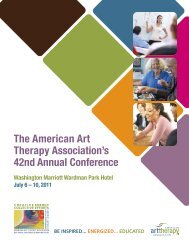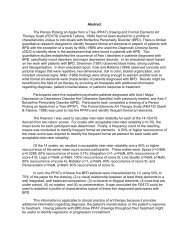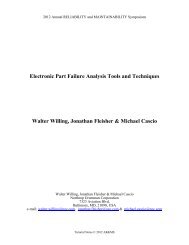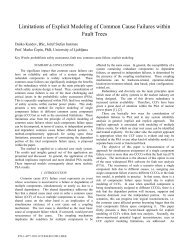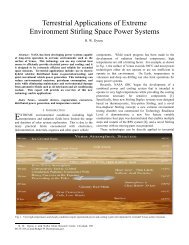Study of Ball Grid and Column Grid Array
Study of Ball Grid and Column Grid Array
Study of Ball Grid and Column Grid Array
You also want an ePaper? Increase the reach of your titles
YUMPU automatically turns print PDFs into web optimized ePapers that Google loves.
Based on review <strong>of</strong> test data versus the predicted values,<br />
the true acceleration factors (AF) vary from one-half to twice<br />
the predicted acceleration factors. To mitigate this<br />
accelerated test variability, it is recommended that a three to<br />
four fold margin be applied to the accelerated life results.<br />
2.4. Recommendations for cga thermal cycle life testing<br />
There are several recommendations for CGA<br />
thermal cycle life testing. These recommendations are<br />
advised for any accelerated life test. One <strong>of</strong> the most<br />
important (especially for larger CGA styles) is that thermal<br />
cycle life testing be performed for each CGA style mounted<br />
to a PWB that represents the final configuration to the<br />
maximum extent possible. The life testing should use the<br />
exact package <strong>and</strong> board mounting configuration <strong>and</strong><br />
physical properties, including package size, internal die size,<br />
ball material size <strong>and</strong> pitch, solder mask, <strong>and</strong> PWB stack-up<br />
(thickness, layers, etc) used in the actual package. If the<br />
exact configurations cannot be tested, IPC-9701, Table 4-3<br />
(Test Exemption Requirements) can be used as a guide to<br />
determine the extent <strong>of</strong> the allowed configuration deviations.<br />
IPC-9701 should be used to define the life test conditions<br />
<strong>and</strong> required sample sizes. The accelerated life test thermal<br />
cycle pr<strong>of</strong>ile should be based upon initial startup conditions<br />
<strong>and</strong> the operational temperature levels anticipated at the<br />
components interconnection interfaces. The dwell duration<br />
at the extremes shall be a minimum <strong>of</strong> 15 minutes. This<br />
dwell time provides sufficient time for the solder to “creep”<br />
or deform under tensional load. Per IPC-9701, the sample<br />
size <strong>of</strong> each device type shall be 33 devices, 32 for life test<br />
<strong>and</strong> one for cross-section. All testing should be performed<br />
using “Daisy Chained” parts <strong>and</strong> PWB interconnections so<br />
that continuous continuity monitoring can be performed with<br />
an IPC approved event detector. The temperature rise from<br />
chip self heating should be reflected in the predicted thermal<br />
cycle numbers. Therefore, differences between the actual<br />
Table 2. Thermal Acceleration Model<br />
This margin provides a level <strong>of</strong> conservatism so that the<br />
variability can be discounted. Consultants for NASA<br />
specifically recommend applying a three-fold (3x) margin<br />
[10].<br />
chip <strong>and</strong> daisy chained chip need to be considered. The<br />
“Daisy Chained” parts should reflect the exact part<br />
configuration (size, materials, layer count, thickness), with<br />
the exception that the I/O be connected in a fashion allowing<br />
for a complete daisy chained interconnection to a properly<br />
designed daisy chained PWB. The corresponding Daisy<br />
chain PWB design should have the same copper <strong>and</strong><br />
insulating layer stack up as the actual board design, again<br />
with the exception that the circuitry connection to the parts<br />
be designed to have continuous daisy chained continuity<br />
loops. The resulting PWB <strong>and</strong> component assembly should<br />
be performed using the identical soldering <strong>and</strong> assembly<br />
processes as the final product.<br />
2.5. Space program CGA thermal life testing<br />
The following is an example <strong>of</strong> a CGA evaluation test.<br />
As illustrated in Table 2, a Day-In-The-Life thermal cycle<br />
mission pr<strong>of</strong>ile was created. Using the Basic C<strong>of</strong>fin<br />
equation, an equivalent accelerated life test value <strong>of</strong> 251<br />
cycles (-40°C to +95°C) was computed as the “1x” lifetime<br />
value (no margin). The application required a “3x” margin<br />
for wear-out distributions, therefore, the resulting CGA<br />
thermal life test cycle requirement was determined to be 754<br />
cycles. The complete mission pr<strong>of</strong>ile includes contributions<br />
from manufacturing/screening, Integration/Test <strong>and</strong> on-orbit<br />
“life” temperature cycling as shown in Table 2.<br />
An Event Detector (Analysis Tech TM , STD Series)<br />
monitored each solder joint during test. The test boards<br />
began to show CGA failures (open circuits) at 879 test cycles<br />
(refer to Table 3). The primary objective <strong>of</strong> the test program<br />
followed by the Weibull analysis is to determine the <strong>Column</strong>





